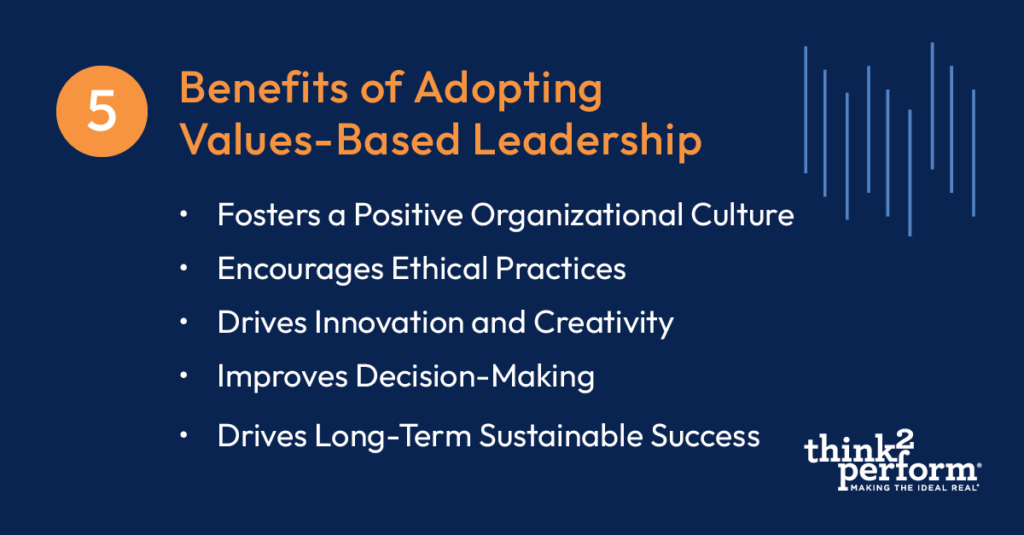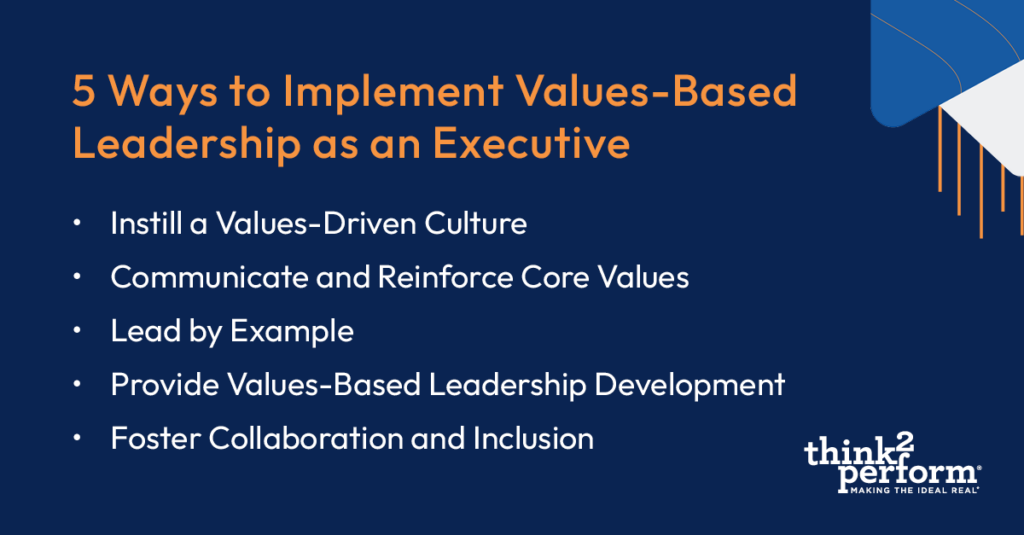“What are your values?” Answering this question requires careful reflection and consideration. People can spend much of their lives trying to align their values and behaviors. Now, consider how exponentially more difficult this challenge is as an executive overseeing an organization. You need to define the organization’s values; align them with strategy, structure, processes and actions; and get buy-in from your workforce.
Values-based leadership can be a powerful differentiator. Tightly aligned, purpose-driven teams can become much more than the sum of their parts. But the stakes are high: When executives don’t align with organizational values, they’re less effective, and employees notice the disconnect. The trickle-down effect can damage morale, engagement, productivity, and business results. At worst, organizations not only fall short but also barely understand what they’re trying to achieve.
Learn more about the concept of values-based leadership. Explore how executives can develop this approach personally and then apply it to their organizations.
What Is Values-Based Leadership?
Values-based leadership is a leadership approach that emphasizes aligning your actions, decisions and behaviors with core values. Values-based leaders prioritize integrity and authenticity. They lead by example in creating positive, ethical organizational cultures.
Core values play a crucial role in shaping leadership behavior. They’re guiding principles that influence leaders’ actions, decisions, and interactions. When people align with their core values, they consistently think, speak and act in alignment with their principles, even when doing so is inconvenient or difficult.
A values exercise can help leaders assess and recognize their core values, helping them set goals, make strategic decisions and build relationships that are aligned and thus more effective.
5 Benefits of Adopting Values-Based Leadership
At the most obvious level, organizations that lack defined values will lack consistency and direction, which hampers collective action, innovation and productivity. But values-based leadership can bring many benefits beyond just the baseline. Here are some of those benefits.
Fosters a Positive Organizational Culture
Values-based leadership can be a powerful force for culture development because the approach forces a conversation about values — yours and the organization’s. While some people’s personal values genuinely don’t mesh with an employer’s, the problem isn’t always that severe.
“I actually think people really want to subscribe to the values you put out,” says Peter Sefzik, senior executive vice president and chief banking officer at Comerica Bank. But employees might not understand why these values matter or how to incorporate them. Furthermore, too many organizations fail to flip the conversation and ask, “What are your values?”
By having that two-way conversation, you open the door to deeper ones — necessary conversations that require vulnerability. “With employees, with colleagues, I think that if they see vulnerability … I think that matters tremendously,” Sefzik says. “And if they see you being vulnerable, it builds relationships. It builds trust, builds culture. And ultimately, I think that builds success for a company.”
Encourages Ethical Practices
Values-driven leadership places a strong emphasis on integrity and ethical decision-making. Leaders who prioritize their core values set the tone for everyone they interact with, contributing to the overall culture.
Values-based leaders consider the impact of their decisions on stakeholders, society and the organization’s long-term reputation. They’re guided by the organization’s values to make choices that are morally right and aligned with the organization’s purpose.
Drives Innovation and Creativity
By empowering team members to examine themselves and define their values and convictions, values-based leaders create an environment that encourages diverse thinking and problem-solving. People can show up to work as themselves and then be their best selves.
With this trust and openness comes greater potential for unique ideas and different approaches to longstanding problems. By leading with values, employees also can improve trust with clients and customers, helping them solve pain points and explore business opportunities.
Improves Decision-Making
Core values act as a compass for leaders, guiding their decision-making processes. These leaders are more consistent and more confident because these choices are built on a solid foundation.
Relevé Financial Group and LIVE WELLthy CEO Dawn Dahlby used to make her decisions based on fear. But when this author, certified financial planner and wealth wellness expert sat down and defined her values, she brought a new perspective to her life. “I started having this life alignment where I aligned who I was to my money,” Dahlby said on Making the Ideal Real, “and I wasn’t afraid to own my own worth and to stand on my own and feel comfortable in my own skin.”
Drives Long-Term Sustainable Success
A values-based approach to leadership prioritizes integrity, authenticity and ethical decision-making — values that don’t go out of style and can’t be disrupted by business trends. Furthermore, living out these values helps executives build trust and credibility with employees and outside the organization.
Living out your values also sets the stage for continuous improvement and the pursuit of sustained optimal performance.

5 Challenges of Adopting Values-Based Leadership
Leadership isn’t easy, especially when you’re trying to influence an entire team, business function or organization in the same direction. Here are some common challenges for executives who practice values-based leadership.
Addressing Conflicts Between Personal and Organizational Values
Leaders may face conflicts between their personal values and the values of the organization they lead. These conflicts can arise when personal values differ from the stated or practiced values of the organization.
That said, your personal values don’t have to 100% overlap. “If it feels like an environment that works for you, and that you feel like you can be your best self there, even though they’re not exactly the same, I think it’s fine,” Kris Petersen, senior vice president at think2perform, said on the Making the Ideal Real podcast. “If you find that you’re not able to be your best self … and it’s in conflict with what you value, it’s probably not the right place to be.”
Dealing With Ethical Dilemmas
Values-based leadership often involves making difficult ethical decisions. Leaders may encounter situations where their values are tested, and they must choose between competing values or conflicting interests.
One way this manifests is when organizational values are too vague. This can create an incentive to chase loopholes or justify ethical exceptions.
Creating Values That Are Inclusive
Inclusivity is a critical aspect of values-based leadership. Leaders must seek input from all stakeholders to uncover blind spots or overlooked perspectives. As our values card exercise illustrates, not everyone will have the same top five, top 10 or even top 20 values — and that’s OK.
Where values-based leadership can go wrong is when the executive closes the door on values and perspectives that don’t match their own or the organization’s exactly.
Sustaining Values During Times of Change
Change is disruptive, both to organizations and individuals, whether it’s personal turmoil, personnel changes, organizational restructuring, mergers and acquisitions, or other shifts. These transitions can disrupt established values and create uncertainty among team members.
While embracing and adapting to change is essential to success, executives and organizations can’t afford to lose sight of themselves in the process. On an episode of Making the Ideal Real, Leela Rao described feeling like change has been the constant in her life. Without her values, she might have found herself adrift.
“What the alignment model did was it kept me grounded and gave me the ability to stay aligned through the values, the goals and the behaviors that I wanted for my life — that was going to get me in the end where I needed to be,” says Rao. “And so even if I felt like the change was sometimes too much, I felt grounded, because I knew that it was within where I wanted to ideally be.”
Overcoming Resistance and Building Buy-In
Like any change, implementing a values-based approach to leadership can create resistance from employees. They might feel like they’re being scrutinized or investigated for their values or fear that they won’t fit in with the organization. If the communication around values isn’t clear and empathetic, resistance can build. Likewise, if managers aren’t trained in how to lead with values, employees can have bad experiences that put them off to the concept of values-based leadership.
Finally, resistance can arise if organizational values are clearly defined but not lived — if they’re “just on the wall,” as Sefzik says.
Developing Your Own Values-Based Leadership Style
Change starts with you. As a leader, if you want to instill a values-focused approach, you need to go first. Here are four steps for doing so.
Define Your Core Values
Naming and ranking your most important values gives you clarity about what matters most to you in life and the behaviors you want to emulate.
This isn’t necessarily an easy exercise. Choosing your top five values out of 50, as our Values Card exercise asks you to do, requires care and reflection. Take the time to do this right.
Identify Areas for Growth and Improvement
Take the time to assess your current leadership practices and whether you are living your values — and whether the people around you see you living those values.
Reflect on situations where you struggled to align your actions and values. Consider gaps in your leadership approach. This self-awareness will help you close those gaps and live more authentically.
Executives can do this at the organizational level. Managers can do this with their employees. Financial advisers can do this with their clients. When Dahlby works with clients, she has them map out their core values so that, when big wealth decisions arise, they can understand whether those decisions are not only financially sound but also align with their values.
Reflect on the Alignment of Personal and Organizational Goals
Start by reflecting on your own core values and how they align with your leadership goals. Consider what values are most important to you and how they influence your decision-making and behavior as a leader.
Reflect on how your values align with the organization’s values and mission. This self-reflection will help you gain clarity on your values and how you can integrate them with organizational values, mission and strategy.
Integrate Values Into Decision-Making and Actions
Once you’ve identified your core values and how they align with organizational goals, consider how you can incorporate those values in making decisions, resolving conflicts and setting priorities.
Seek opportunities to align your actions and values in private and public ways. Check in on yourself regularly and ask trusted employees, advisers or coaches to call you out when you’re out of alignment. This integration will help you lead with authenticity and inspire others to do the same.

Implementing Values-Based Leadership in Your Organization
The biggest, and most complex, step in values-based leadership is extending beyond the individual or small group to the large organization. Here are five steps executives can take to make values-based leadership come alive.
Instill a Values-Driven Culture
Values-driven leadership starts by clearly defining and articulating the organization’s core values. These values should reflect the organization’s mission, goals and desired behaviors. Embed the values into the organization’s policies, practices and decision-making processes, and culture will follow.
When values are clear and self-evident in the culture, people begin to realize they’re all pulling in the same direction. Values alignment also can be a helpful criterion when assessing potential hires for who has the greatest potential for success in your organization.
Communicate and Reinforce Core Values
Clearly communicate core values to the team members, ensuring that they understand the importance of these values and how they guide decision-making and behavior within the organization.
Make these values meaningful but also simple to understand. If employees can’t remember the values off the top of their head, they’ll struggle to live them daily.
Regularly reinforce the values through various channels, such as team meetings, newsletters and other internal communications. Share stories and examples that demonstrate how the values are lived in the organization.
“If you can have your values top of mind, you’re going to be able to not only reflect on them, but you’re going to be able to use those values when you’re in a tough situation,” Peterson says.
Lead by Example
Executives must demonstrate organizational values in their actions and interactions. Your behavior sets the tone for the organization and influences how team members perceive and embrace the values. Be as transparent as possible about how values drive key decision-making processes.
This authenticity and consistency will influence others, including managers, to embrace the values and integrate them into their own work.
Provide Values-Based Leadership Development
Offer leadership development programs and training that focus on values-based leadership. Provide opportunities for leaders and aspiring leaders to enhance their understanding of the core values and develop the skills necessary to lead with integrity and authenticity.
Leaders who combine strong values with emotional competency perform better under pressure, effectively inspire and engage employees, and consistently and strategically make better decisions.
Foster Collaboration and Inclusion
Values-based leadership emphasizes collaboration, inclusivity, and respect for diverse perspectives. Create opportunities for team members to collaborate, share ideas and contribute to decision-making processes.
Encourage open dialogue and opportunities for employees to suggest ideas that reinforce values or call out misaligned behaviors. But make sure open dialogue is truly open — employees also should be able to express how their values can improve the organization, even if they aren’t precisely the same.
Amplify Your Values-Based Leadership
Values-based leadership is a personal journey, but it also can inspire success in small teams and the largest organizations. Executives have a powerful opportunity to live as their best selves while aligning their entire workforce to pull in the same direction with integrity. Start by exploring your values, assessing your current alignment and striving to match your behaviors and values each day. Then, help your people do the same.
Learn how think2perform can help you with cultural transformation, including team-based development and research-based assessment tools.



